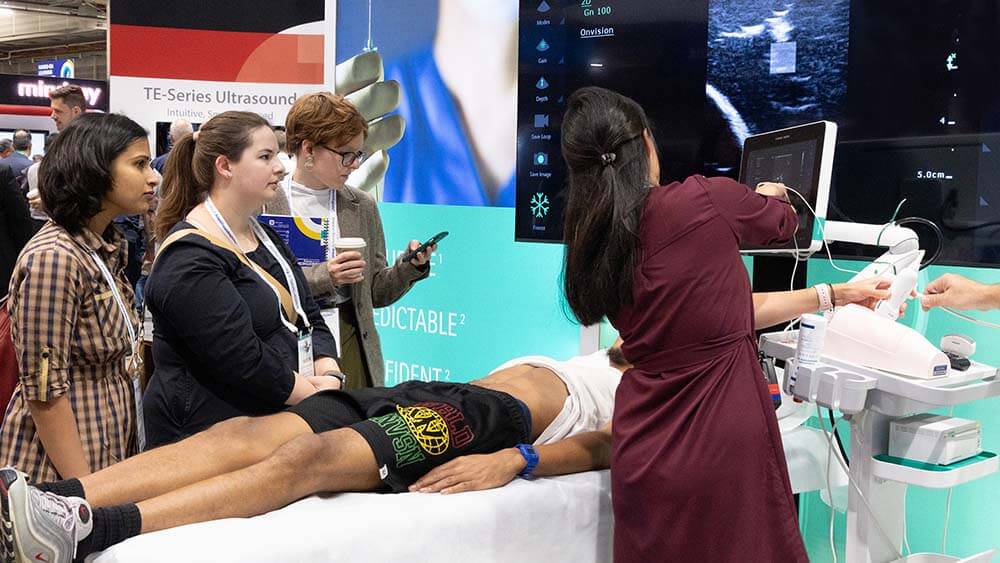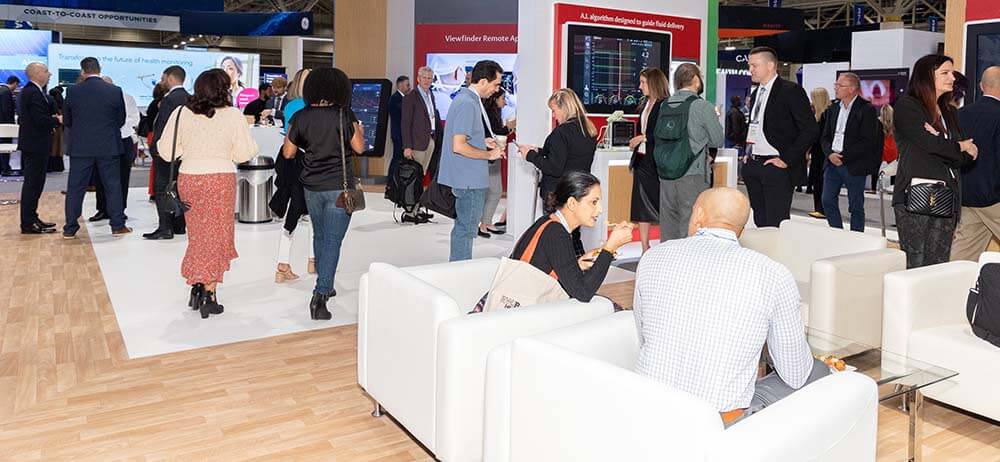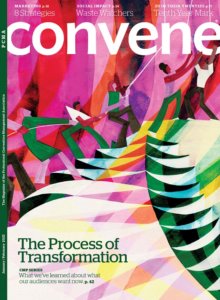
The American Society of Anesthesiologists’ ANESTHESIOLOGY 2022 was held in person in New Orleans. (Courtesy of ASA)
Convene editors reached out to a handful of organizations to see how they are incorporating lessons learned from the ways the pandemic affected their audiences, stakeholders, and members into their go-forward strategies. This is one in a series of stories from the January/February issue of Convene.
When the American Society of Anesthesiologists (ASA) went virtual for ANESTHESIOLOGY 2020, ASA’s Annual Meeting, one pain point the society made a significant effort to address will likely ring familiar to most organizations similarly challenged — the exhibit hall. For its 2020 event, ASA worked with digital event provider Intrado (now Notified) to build out a virtual exhibit space. But knowing attendees weren’t likely to interact with exhibitors on the same level as they would at a live show, ASA nudged exhibitors toward investing in alternatives, like sponsored online educational content and networking sessions.
Overall, that approach was fairly successful. “We will stick with our formula of deemphasizing the exhibit hall/booth in the future,” Paul Pomerantz, FACHE, CEO of ASA, told Convene at the time, “but we have work to do on strengthening the opportunities for engagement and better ways to share their educational resources.”
Fast-forward to 2023 and ASA has returned to doing what has worked best for its audience — prioritizing the in-person experience. Both ASA’s 2021 and 2022 meetings were held in person in San Diego and New Orleans, respectively, and ANESTHESIOLOGY 2023 will convene Oct. 13-17 in San Francisco. Meanwhile, ASA continues to offer a scaled-down selection of online content and education for attendees who can’t attend in person. In December, we checked in with ASA’s director of meetings, Kevin Kirberg, on what has changed and why, as well as what challenges he sees ahead for the events industry.

“What our attendees like and value — and what our exhibitors have told us they value — is the highly engaged level of interaction that happens on a live exhibit hall floor,” said ASA’s director of meetings, Kevin Kirberg.
What lessons did you learn from hosting the exhibit hall virtually in 2020 and what does that space look like now?
As we’ve gone back to that model of an in-person exhibit hall, we really did see the limitations that everyone involved experienced when we went virtual. What our attendees like and value — and what our exhibitors have told us they value — is the highly engaged level of interaction that happens on a live exhibit hall floor. At least in the one time we tried to do it, that couldn’t be equally captured in a virtual space. When it comes to the exhibit hall, we have not kept any hybrid component. We’ve gone back to doing a lot … to drive attendees to the exhibit hall [by offering sponsorship of] non-CME education. With the investment that they’re making in our meeting, exhibitors find more value in that in-person experience.
What’s different about your overall digital event strategy now compared to 2020?
In 2020 and even 2021, when we were trying hybrid, it was costing us a lot of money to do it [through an external provider]. As we’ve continued to build out our in-house learning management system, which we use for delivery for all of our education, we found ways to provide that hybrid experience for those who don’t come to the meeting in person. They’re used to using the technology, they’re familiar with it, and it doesn’t really cost us much more because we’re utilizing features that already existed.

Kevin Kirberg
We’ve also really tried to target key content and schedule it so we’re only livestreaming from one or two rooms. We’re working closely with our AV vendor partner, Encore, to figure out how can we do this best but not spend any more money. We’re not trying to replicate everything; we don’t want to be everything to everyone because then we end up not doing much good for anyone, right? That’s what we tried to do in 2020 and to an extent in 2021, because we didn’t know where to stop. We got feedback from our event attendees on the virtual side — how much content are they looking for? How many CME hours do we need to provide to make it a value to them? Focusing on those key aspects of the education content, whether it’s in person or virtual, I think that’s how we’ve been able to find that sweet spot. I suspect that will probably become a permanent hallmark of our meeting going forward.
Looking ahead now, what challenges and/or opportunities do you foresee for the events industry?
One of the ongoing challenges for us, and I think for everyone when I talk to my colleagues, is just trying to figure out what the expectation will be for in person in the future. We were really in the dark this year in terms of what, from a budgetary standpoint, can we expect for attendance — is it going to look like 2019? Is it going to look like 2021? Is it going to be somewhere in between? How do we figure out from a cost standpoint where to put our resources?
We’re not back to normal. A lot of meetings still require proof of vaccination or negative COVID tests to attend. At what point does the audience start to feel enough is enough? That’s a big cost for us, to have processes in place for testing and documentation requirements.
There is still a huge learning curve for all of us, and we’re still trying to figure out, again, where that sweet spot will be as we go forward. I don’t think we’ll ever get back to exactly as things were in 2019; I think there will be a new reality. This will be better for everyone, really.
If we continue to come back strong and robust, it will be good for the hospitality industry as a whole and it will be good for members of associations like ours who are seeking better ways to connect with the organization, utilize their membership, and find value from what we provide.
RELATED: Learn more about how the American Society of Anesthesiologists’ conference went virtual at “What to Do About the Virtual Exhibit Hall.”

The Complete January/February CMP Series
- AMDA’s Journey to Meeting Back In Person
- Medical Society Finds Success by Getting Uncomfortable
- How Short-Term Activations Can Create Lasting Positive Change
- Breaking Through the Mindset of Digital vs. In-person Events
- Finding the ‘Sweet Spot’ for Anesthesiologist Group’s Annual Meeting
- Science Group’s Hybrid Meetings Improve Access, Affordability
- Acquisition of a Fan Expo Opens Doors for Nonprofit
